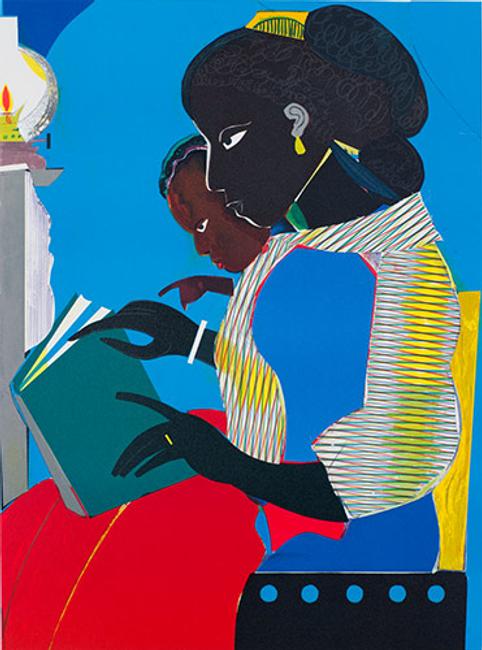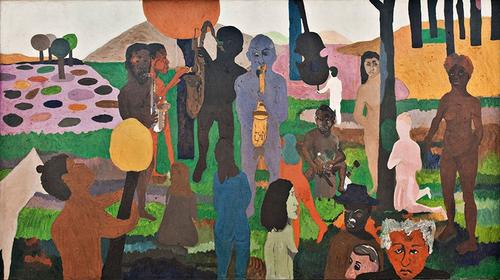Oct. 19, 2019 to Jan. 20, 2020.
Afrocosmologies: American Reflections presents a window into a dynamic cosmos of influences that shape contemporary American art. This exhibition is a collaboration of the Wadsworth Atheneum Museum of Art, The Amistad Center for Art & Culture, and the Petrucci Family Foundation Collection of African-American Art. Drawing from over one hundred art objects, with the Petrucci Family Foundation contributing sixty-eight, these works of art span various media, present potent voices, and pose multiple questions. Afrocosmologies is an exhibition about presence, faith, authentic experiences, and representations of gender within a family of people born to many cosmological influences. With a predominant arc between the twentieth and twentyfirst century, the exhibition brings together the work of an incredible assortment of artists including Romare Bearden, Dawoud Bey, Elizabeth Catlett, Willie Cole, Melvin Edwards, Titus Kaphar, Lois Mailou Jones, Kerry James Marshall, Alison Saar, Hale Woodruff, Shinique Smith, and Kehinde Wiley along with many additional artists of note.


Afrocosmologies examines successive generations of African American artists expressing their unique and evolving worldviews. Those cosmologies illustrate particular aspects of American history but are informed by African philosophical, ritual, and cultural systems that migrated here in memory. It's human to look for order in the universe--to develop a cosmology or system of belief. Art reflects this search for understanding. From the late nineteenth century to now African American artists have explored spirituality and culture by telling stories and when finally allowed, creating imagery that validated their connections to cosmology. Religion (faith), myth, inherent humanity, non-traditional colors and patterns are all themes emerging from the rich aesthetic traditions of West African and other cultures. Afrocosmologies examines these works of art through four themes: Nature, Gods and Humanity, Ritual, and Origins.
"With such remarkable works of art to work with--seminal pieces
collected over the past century by the Wadsworth, a dynamic and emerging
spectrum of artists in the Petrucci collection, and The Amistad's
significant connection to history and New England--we wanted to attract
the widest possible audience," says Frank Mitchell, Executive Director
of The Amistad Center for Art & Culture and curator of the
exhibition. "The cosmology concept and its varying dynamism over time,
provided a natural framework for exploring issues of faith and community
that continue to define the field."
To more accurately and effectively present the contributions of African American artists is to pave the way for corrective legitimacy and complete the canvas of American history.
"When we took measure of history at the Wadsworth Atheneum and The Amistad Center by looking at the collections' growth and the exhibitions organized over the past fifty years, we were reassured by our consistent commitment. Our evolving vision has led to necessary conversations and the emergence of consequential artists, right here at 600 Main Street," says Thomas J. Loughman, Director and CEO of the Wadsworth. "In the Petrucci Family Foundation collection we saw that same excitement and daring that we prize at the Wadsworth. The Petrucci Foundation is a great partner in helping us and The Amistad bring this vivid history and culture into focus."
To more accurately and effectively present the contributions of African American artists is to pave the way for corrective legitimacy and complete the canvas of American history.
"When we took measure of history at the Wadsworth Atheneum and The Amistad Center by looking at the collections' growth and the exhibitions organized over the past fifty years, we were reassured by our consistent commitment. Our evolving vision has led to necessary conversations and the emergence of consequential artists, right here at 600 Main Street," says Thomas J. Loughman, Director and CEO of the Wadsworth. "In the Petrucci Family Foundation collection we saw that same excitement and daring that we prize at the Wadsworth. The Petrucci Foundation is a great partner in helping us and The Amistad bring this vivid history and culture into focus."

"We are a collection that has its genesis in a deep appreciation of
African American culture and are dedicated to acquiring works of art
that speak to the resilient, creative, and persistent humanity within
Black American culture," says Petrucci Family Foundation curator and
artist Berrisford Boothe. "Within the African American community and now
across America at large, conceptions of race, gender, and community
that once seemed fixed are now in flux or at least open for discussion.
What was once a binary system of black or white aesthetics, now involves
globally transplanted voices of color that exist within, are elevated
by, and add authentic cosmological dynamism to American cultural
conversations." In this continuing conversation, there must be
sensitivity, but also the recognition that America's history and its
impact cannot be eluded.
The Wadsworth is pleased to create a context for these ideas and for the creative output of African American artists to be explored through this exhibition's themes. Enslaved Africans brought a deep cosmological appreciation of the natural world. It is a system that supported relationships with gods and ancestors. The land had to be worked as slaves, but the enslaved also lived through and worshipped in partnership with water and land. The land always has been the setting for nurturing new religious and syncretic practices. Nature: The World as We Experience It includes works by Bob Thompson, Martha Jackson Jarvis, Howardena Pindell, Richard Watson and others who take nature's presence as inspiration to consider histories and imagine futures.
The Wadsworth is pleased to create a context for these ideas and for the creative output of African American artists to be explored through this exhibition's themes. Enslaved Africans brought a deep cosmological appreciation of the natural world. It is a system that supported relationships with gods and ancestors. The land had to be worked as slaves, but the enslaved also lived through and worshipped in partnership with water and land. The land always has been the setting for nurturing new religious and syncretic practices. Nature: The World as We Experience It includes works by Bob Thompson, Martha Jackson Jarvis, Howardena Pindell, Richard Watson and others who take nature's presence as inspiration to consider histories and imagine futures.
Gods and Humanity: Which Gods and Our Relationship to Them
includes works by artists such as Palmer Hayden, Willie Cole, Didier
William, Kenturah Davis, and Carl Joe Williams. Williams incorporates
portraits of Black mystical figures as everyday saints. Religious
tradition carried by many who endured the Middle Passage was conveyed
through stories, songs, and movement. Christianity limited the scope of
divinity but the familiar did not disappear as enslaved Africans
developed syncretic forms of worship that combined elements of both
traditions.
Worship sustained the captives and integrated diverse groups of Africans who through spirituality, became united in their commitment to freedom. Through works by Hale Woodruff, Richmond Barthé, Ralph Chessé, Addison Scurlock, and others, Ritual: Shared Worship Experiences looks at the new cosmologies, or ways of ordering the spiritual world, that affirmed new identities and communities in the Americas.
Origins: Preparation for the Journeys presents the vitality of Afrocosmologies through the art of Kerry James Marshall, John Biggers, Romare Bearden, Barbara Bullock, Sharif Bey, Ed Johnetta Miller, and others. Generations of African American artists and performers have struggled with ways to present the experience of slavery and Africa's bearing. From Reconstruction Era artists, to the Harlem Renaissance, to the Black Arts Movement, and continuing today, there is a reassessment of history and celebration of Africa's influence on contemporary culture.
Afrocosmologies will be on view October 19, 2019 through January 20, 2019. During the exhibition, six artists whose work is featured in the show will be participating in public programs at the Wadsworth. All are welcome.
Exhibition Catalogue
Afrocosmologies: American Reflections will be accompanied by a 156-page, fully illustrated catalogue with essays by Frank Mitchell, Berrisford Boothe, Claudia Highbaugh, and Kristin Hass--to be released in October 2019.
Worship sustained the captives and integrated diverse groups of Africans who through spirituality, became united in their commitment to freedom. Through works by Hale Woodruff, Richmond Barthé, Ralph Chessé, Addison Scurlock, and others, Ritual: Shared Worship Experiences looks at the new cosmologies, or ways of ordering the spiritual world, that affirmed new identities and communities in the Americas.
Origins: Preparation for the Journeys presents the vitality of Afrocosmologies through the art of Kerry James Marshall, John Biggers, Romare Bearden, Barbara Bullock, Sharif Bey, Ed Johnetta Miller, and others. Generations of African American artists and performers have struggled with ways to present the experience of slavery and Africa's bearing. From Reconstruction Era artists, to the Harlem Renaissance, to the Black Arts Movement, and continuing today, there is a reassessment of history and celebration of Africa's influence on contemporary culture.
Afrocosmologies will be on view October 19, 2019 through January 20, 2019. During the exhibition, six artists whose work is featured in the show will be participating in public programs at the Wadsworth. All are welcome.
Exhibition Catalogue
Afrocosmologies: American Reflections will be accompanied by a 156-page, fully illustrated catalogue with essays by Frank Mitchell, Berrisford Boothe, Claudia Highbaugh, and Kristin Hass--to be released in October 2019.